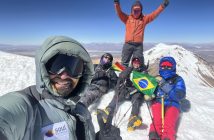By Rodrigo Granzotto Peron

Karakoram view form Askole. Photo Max Kausch
13 – BROAD PEAK TRAVERSE
What would one do after completing the 14x8000ers? Retire and enjoy the status? Not Alberto Iñurrategi; he is the guy. Here goes the list of good stuff Alberto has being into after the 14:
2004 – Gasherbrum III (summit)
2006 – Everest – Supercouloir Route (attempt)
2006 – Shivling (summit)
2008 – Gasherbrum IV (fore summit)
2009 – Makalu – West Pillar Route (attempt)
2009 – Everest – Supercouloir Route (attempt)
We witness another peak performance from Alberto this year. With regular rope mates Mikel Zabalza and Juan Vallejo Llamos, they performed in great style the third complete traverse of all three Broad Peaks (N, C and Main). This was for sure the most important event on the season.
First the Spaniards set a new route on the difficult slopes of the West Face of Broad Peak North (7500m). However, the planned traverse had to be aborted on that occasion due to strong winds. On descent, Alberto alerted that the new line was a mere appetizer.
A week later, they summited again BP N and proceeded to Broad Peak Central (8016m). The summit of this subsidiary 8000er was reached after a tough 15-hours fight against deep snow and severe conditions. These difficulties lead Mikel and Juan to turn back without completing the traverse. But Iñurrategi, showing his legendary endurance, made it to the top of Broad Peak I (8047m), thus bagging the three summits of BP massif.
This was the third complete traverse of the entire ridge of Broad Peak, after the Poles (1984 Jerzy Kukuczka and Wojciech Kurtyka) and the Japanese (1995 Toru Hattori, Toshiyuki Kitamura and Masafumi Tokada). It is important to mention that all traverses were from north to south; everybody started with BP North Peak.
A curiosity is that the Spanish climbers topped out Broad Peak Central almost on its 35th birthday (the first ascent was July 28, 1975).
14 – THE SHADOWS OF DARTH K2
K2 is a very difficult horse to ride. On the last 13 seasons (1998-2010), summit was reached only 6 times (2000, 2001, 2004, 2006, 2007 and 2008). The other 7 seasons were in blank. The most successful season was 2004, with 51 summits. Other good seasons were 2000 and 2007. On the other hand, on 1998, 1999, 2002, 2003, 2005, 2009 and 2010 K2 stroke back and let no climber pass his guard onto the very summit.
In conclusion, when expeditions arrive at BC on the beginning of a season there is only about 45% of chance that some climber will summit K2 (the lowest rate on all 8000ers).
Here goes a resume of what happened on recent years:
1998 – no summit
1999 – no summit
2000 – 25
2001 – 9
2002 – no summit
2003 – no summit
2004 – 51
2005 – no summit
2006 – 4
2007 – 31
2008 – 18
2009 – no summit
2010 – no summit
The present season was enlighted by a large amount of top climbers: Ralf Dujmovits, Maxut Zhumayev, Vassili Pivtsov, Fredrik Ericsson, Gheorge Dijmarescu, Luis Benitez, among others.
Other relevant aspect on K2 was the massive feminine presence, with Anna Czerwinska, Gerlinde Kaltenbrunner, Kinga Baranowska, Leila Esfandiari, Meagan McGrath, Tamara Stys, Patrycja Jonetzko and Lakpa Sherpani.
On the first half of the season, the only interesting events on K2 were the partial ski descents by Fredrik Ericsson (SWE). The first round was with Trey Cook (UK), on Cesen Route, from 6500m to BC. After, on July 26, a second descent, now from C4 (c 8000m) to BC. Fredrik would try the complete ski descent of K2, but on the summit push with Gerlinde, a fatal fall shortened the beautiful career of this great climber and extreme skier.
With K2 in bad mood and after the death of Fredrik, almost all parties gave up, leaving Darth Chogori behind. The voyage home, however, was another adventure for climbers. Heavy rain and tremendous floods plagued Pakistan, affecting 20 million people in an area as large as Floridas state (the worst I have ever seen in my life, Karrar Haidri, the ExWeb correspondent, said). The floodings and landslides damaged the roads between Gilgit, Skardu and Askole (the drive to Skardu was hairy according with some climbers). Several flights were postponed or canceled, and the major cities were in chaos.
Some climbers were patient enough and a second summit wave on middle August resulted on huge polemics. One of the darkest chapters in the history of high mountaineering was written by Austrian climber Christian Stangl. He is in pursuit of the Second Seven Summits, which consists in the second highest peak on each Continent. On K2, Stangl came back from the summit bid with an incredible claim: a skyrunning conquest through the Abruzzi Spur in 41-hours (70-hours in total, counting also the descent). If confirmed, this would be the second fastest ascent of K2. Back on BC, Stangl said: If mountain climbing were as the last 70 hours here at K2, I would immediately stop.
The story of the Austrian, however, did not convince other climbers at BC. For Georghe Dijmarescu, no summits this year, guarantee. When you will hear the entire story, you will laugh. Kazakh top climber Maxut Zhumayev doubted Stangls claim either. And Zsolt Torok commented that his Sherpas found Stangls stuff (including a tent, an ice pick, a book and some food) hidden under some rocks a little away from the Abruzzi Spur (near C3, at about 7500m). The question was why the gear was hidden there? This could indicate that the climber did not proceed to the summit, but turned back from that point and tried to switch the evidences to below the carpet.
The suspects got reinforcement from the internet. Website k2bottleneck presented more arguments against Christian Stangl, including the analysis of the only proof of the summit. The picture the Austrian released to media lacks the EXIF information (note: EXIF shows the date of the picture and other technical data). Was the picture altered in Photoshop? Later, ExWeb discovered that the location of the picture was C3, and not the summit.
At first, the climber denied the accusations: Even publishing summit pics doesnt help, there will be always someone who will have doubts. I will stop here with publishing any further reports or details. Later, he could not handle all the pressure and confessed to website orf.at that the proof was fabricated and that he only imagined the victory. On his version, in the last attempt, I reached a trance-like state of consciousness in which I was convicted to stand on the highest point.
I hate to be rude, but the argument is ridiculous! He orchestrated the farse since the beginning. The gear was hidden. The picture was altered. He tried to deceive his colleagues at BC. He insisted on his lies publishing untrue notes. This is very serious!
The only correct statement from Christian Stangl on the season was: If climbing 8,000-meter-plus peaks (and only there) includes experiencing all the bad rumours and threats I have had to endure since summiting K2, I dont want to be a member of this climbing community anymore (official statement, August 30, 2010). You are right! After all this, youre out of the community
Fortunately, in the end the truth prevailed. In Abraham Lincoln´s words: You can fool all the people some of the time, and some of the people all the time, but you cannot fool all the people all the time.
And so, another K2s season is over, with no summit and two casualties. Fatality rate: extreme.
Note: The coverage of the above events was very complete on several websites, but the best articles were published on Explorerweb. Check there the previous stories about this subject.
15 – THE GIANT NORTH EAST WALL OF GASHERBRUM I
Because of logistics, the base-camps on all four 8000ers on Baltoro are on the southern slopes of these giants. So, it is natural that almost all ascents are from the South. Summits from the North are very scarce:
K2 – six seasons (1982, 1983, 1990, 1994, 1996 and 2007)
G1 – none
BP – three seasons (1984, 1995 and 2010)
G2 – one season (2007)
The Italians are becoming the experts on the boreal slopes of Pakistans 8000ers. In 2007, Daniele Bernasconi, Michele Compagnoni and Karl Unterkircher completed the first ascent of the N Face of Gasherbrum II. And in 2008, Karl Unterkircher, Walter Nones and Simon Kehar experienced the direct central slopes of the N Face (Rakhiot Flank) of Nanga Parbat, but Karl sadly passed out after falling in a crevasse (note: Walter Nones is back, and will try a new line on Cho Oyu).
On the current season, another experienced group, including Herve Bermasse, Mario Panzeri and – again – Daniele Bernasconi, went to Pakistan determined to challenge the North East Face of Gasherbrum I. The leader of the expedition was legendary Agostino Da Polenza. They faced bureaucratic problems that delayed the arrival at BC in almost 20 days. Worse, the excessive snow on high slopes made the avalanche-prone route too dangerous to try.
And so the expedition was unfortunately called off, but the guys did not return home empty-handed. They made the first ascent of a nearby 6000er (Venere Peak, see special topic below).
*This Chronicle is based on preliminary data and under analysis. Some will be revisited in the following months, with possibly a few corrections to be done by then.
















